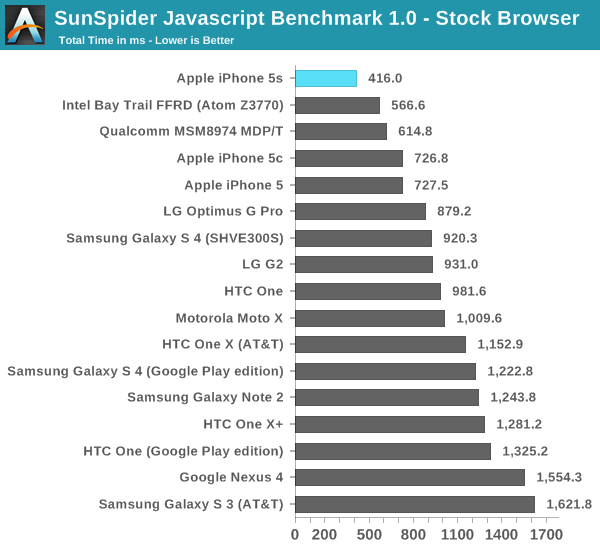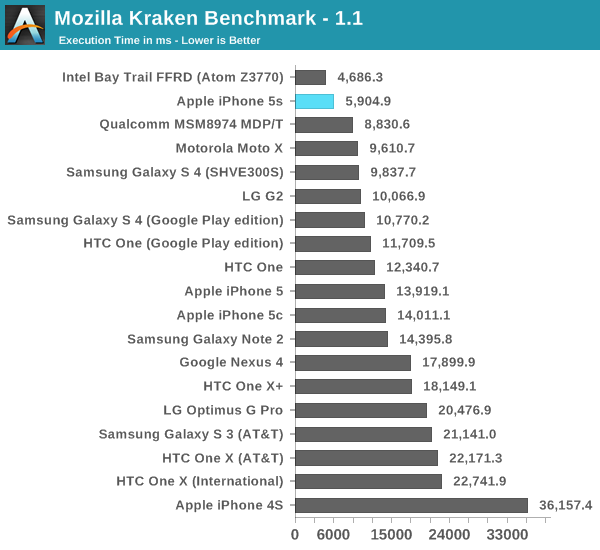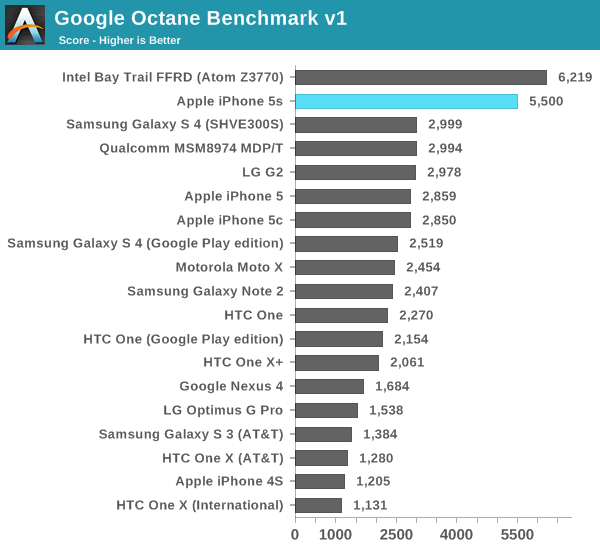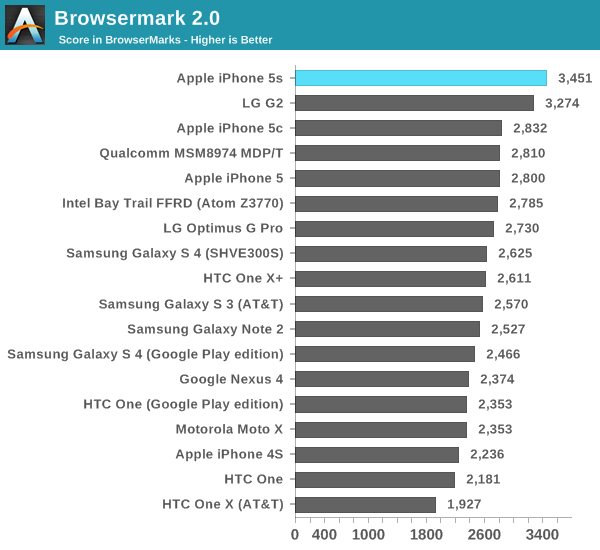The iPhone 5s Review
by Anand Lal Shimpi on September 17, 2013 9:01 PM EST- Posted in
- Smartphones
- Apple
- Mobile
- iPhone
- iPhone 5S
CPU Performance
For our cross-platform CPU performance tests we turn to the usual collection of Javascript and HTML5 based browser tests. Most of our comparison targets here are smartphones with two exceptions: Intel's Bay Trail FFRD and Qualcomm's MSM8974 Snapdragon 800 MDP/T. Both of those platforms are test tablets, leveraging higher TDP silicon in a tablet form factor. The gap between the TDP of Apple's A7 and those two SoCs isn't huge, but there is a gap. I only include those platforms as a reference point. As you're about to see, the work that Apple has put into the A7 makes the iPhone 5s performance competitive with both. In many cases the A7 delivers better performance than one or both of them. A truly competitive A7 here also gives an early indication of the baseline to expect from the next-generation iPad.
We start with SunSpider's latest iteration, measuring the performance of the browser's js engine as well as the underlying hardware. It's possible to get good performance gains by exploiting advantages in both hardware and software here. As of late SunSpider has turned into a bit of a serious optimization target for all browser and hardware vendors, but it can be a good measure of an improving memory subsystem assuming the software doesn't get in the way of the hardware.

Bay Trail's performance crown lasted all of a week, and even less than that if you count when we actually ran this benchmark. The dual-core A7 is now the fastest SoC we've tested under SunSpider, even outpacing Qualcomm's Snapdragon 800 and ARM's Cortex A15. Apple doesn't quite hit the 2x increase in CPU performance here, but it's very close at a 75% perf increase compared to the iPhone 5. Update: Intel responded with a Bay Trail run under IE11, which comes in at 329.6 ms.
Next up is Kraken, a heavier js benchmark designed to stress more forward looking algorithms. Once again we run the risk of the benchmark becoming an optimization target, but in the case of Kraken I haven't seen too much attention paid to it. I hope it continues to fly under the radar as I've liked it as a benchmark thus far.

The A7 falls second only to Intel's Atom Z3770. Although I haven't yet published these results, the 5s performs very similarly to an Atom Z3740 - a more modestly clocked Bay Trail SKU from Intel. Given the relatively low CPU frequency I'm not at all surprised that the A7 can't compete with the fastest Bay Trail but instead is better matched for a middle of the road SKU. Either way, A7's performance here is downright amazing. Once again there's a performance advantage over Snapdragon 800 and Cortex A15, both running at much higher peak frequencies (and likely higher power levels too, although that's speculation until we can tear down an S800 platform and a 5s to compare).
Compared to the iPhone 5, the 5s shows up at over 2.3x the speed of last year's flagship.
Next up is Google's Octane benchmark, yet another js test but this time really used as a design target for Google's own V8 js engine. Devices that can run Chrome tend to do the best here, potentially putting the 5s at a disadvantage.

Bay Trail takes the lead here once again, but again I expect the Z3740 to be a closer match for the A7 in the 5s at least (it remains to be seen how high the iPad 5 version of Cyclone will be clocked). The performance advantage over the iPhone 5 is a staggering 92%, and obviously there are big gains over all of the competing ARM based CPU architectures. Apple is benefitting slightly from Mobile Safari being a 64-bit binary, however I don't know if it's actually getting any benefit other than access to increased register space.
Our final browser test is arguably the most interesting. Rather than focusing on js code snippets, Browsermark 2.0 attempts to be a more holistic browser benchmark. The result is much less peaky performance and a better view at the sort of moderate gains you'd see in actual usage.

There's a fair amount of clustering around 2500 with very little differentiation between a lot of the devices. The unique standouts are the Snapdragon 800 based G2 from LG, and of course the iPhone 5s. Here we see the most modest example of the A7's performance superiority at roughly 25% better than the iPhone 5. Not to understate the performance of the iPhone 5s, but depending on workload you'll see a wide range of performance improvements.










464 Comments
View All Comments
ESC2000 - Saturday, September 21, 2013 - link
So inexplicably the air has this great GPU coupled with a crappy screen that limits the GPU's impact. Then on the windows ultrabooks we have generally better screens (at least on the ones that have similar cost to the air) but less good GPUs.akdj - Tuesday, October 8, 2013 - link
Touché. I'll give ya that one. While I do love my MBA for travel, the screens suck! Point was not to compare displays----rather iGPU technology movementvcfan - Wednesday, September 18, 2013 - link
I doubt the A7X is even close to 300GFLOPStipoo - Wednesday, September 18, 2013 - link
78 times 2. It'll probably be close to 160 Gflops, if historical A*X series performance doubling is to be followed.DeciusStrabo - Wednesday, September 18, 2013 - link
Admittedly the original 11" MBA was a dog in terms of performance when it was released. Still 1/3-1/2 (depending on the benchmark) of the speed of my i3-3220 Home Server isn't exactly bad for a phone.jeffkibuule - Wednesday, September 18, 2013 - link
Didn't the original 11" MBA have overheating problems? That thing was a toaster.coolhardware - Tuesday, September 17, 2013 - link
Very nice review as always Anand :-)I especially enjoyed checking out the display closeups and charts. As you mention, Apple's display size and pixel density are both falling behind flagship phones from other manufacturers, this list http://pixensity.com/list/phone/ puts it well outside of the top 10.
However, Apple displays are generally pretty nice to look at. I cannot help but wonder if Apple is going to get any major display breakthroughs in future generations, or if other manufacturers (Samsung, LG, or other) will be able to surpass it... anyhoo, thanks for the nice review!
PS if anyone has subjective opinions after viewing the 5s' display versus other flagships, I would appreciate hearing about it!
Impulses - Tuesday, September 17, 2013 - link
It's not like Apple's designing their display in Cupertino... I'm sure they have a large degree of control in order to get the specs they need and the calibration etc, but if there's any sorta revelation in display tech it'd come from the labs of the people that actually make them (Samsung, LG, Sharp, etc).Impulses - Tuesday, September 17, 2013 - link
Oh and my subjective opinion on current flagship displays is that I'd still take an IPS/super LCD/whatever over the typical over saturated AMOLED, the Moto X made a strong case for using AMOLED for it's active notifications but ehh... I like LG's tap to wake gimmick on their recent models, and after owning two 4.3" devices and a 4.6-4.7" (all with capacitive buttons) I'm actually yearning for something a bit more compact. I think the Moto X is a near perfect fit, although it does sacrifice some screen space for the buttons... I thought on screen buttons were pointless at first because none of the early devices that used them had less bezek space nor where they smaller, but we're finally seeing that become a reality with the X and the G2 so I think I'm on board now. Die bezels die! (along with menu etc, HTC dumping the multi task button bothered me tho, one of their few design missteps IMO)coolhardware - Tuesday, September 17, 2013 - link
Thank you Impulses for the nice analysis.I too really like the Moto X. It seems like it hits the sweet spot in size/capability plus it is actually available on my carrier (US Cellular). I wish that all carriers got the Moto X customization options though because I find that to be a pretty cool feature:-)
I will eventually be replacing my Galaxy Note 2 with giant extended battery:
http://goo.gl/TxUnez
with something and right now it is a toss up between the upcoming Galaxy Note 3 and the Moto X. I really dislike how sluggish my Note 2 can be and I mainly blame that on Samsung's skin on top of Android :-( That is a big plus for the Moto X since I hear it is pretty clean in that respect.
My new choice may be Moto X + Nexus 7 FHD rather than Note 3.
Any other thoughts/opinions on the topic?